Abstract
To evaluate whether long term exposure to 2-ethoxyethanol (2EE) may affect semen quality, a cross sectional study was conducted among men exposed to 2EE used as a binder slurry in a metal castings process. Full shift breathing zone exposures to 2EE ranged from non-detectable to 24 ppm (geometric mean 6.6 ppm). Because of the potential for substantial absorption of 2EE through skin exposure, urine measurements of the metabolite of 2EE, 2-ethoxyacetic acid (2EAA) were conducted, showing levels of 2EAA ranging from non-detectable to 163 mg 2EAA/g creatinine. Only 37 exposed men (50% participation) and 39 non-exposed comparison (26% participation) from elsewhere in the plant provided a sperm sample. A questionnaire to determine personal habits, and medical and work histories, and a physical examination of the urogenital tract were also administered. The average sperm count per ejaculate among the workers exposed to 2EE was significantly lower than that of the unexposed group (113 v 154 million sperm per ejaculate respectively; p = 0.05) after consideration of abstinence, sample age, subjects' age, tobacco, alcohol and caffeine use, urogenital disorders, fever, and other illnesses. The mean sperm concentrations of the exposed and unexposed groups did not significantly differ from each other (44 and 53 million/ml respectively). No effect of exposure to 2EE on semen volume, sperm viability, motility, velocity, and normal morphology or testicular volume was detected, although some differences in the proportion of abnormal sperm shapes were observed. These data suggest that there may be an effect of 2EE on sperm count among these workers, although the possibility that other factors may be affecting the semen quality in both exposed and unexposed men in this population or that the results reflect bias introduced by the low participation rates cannot be excluded.
Full text
PDF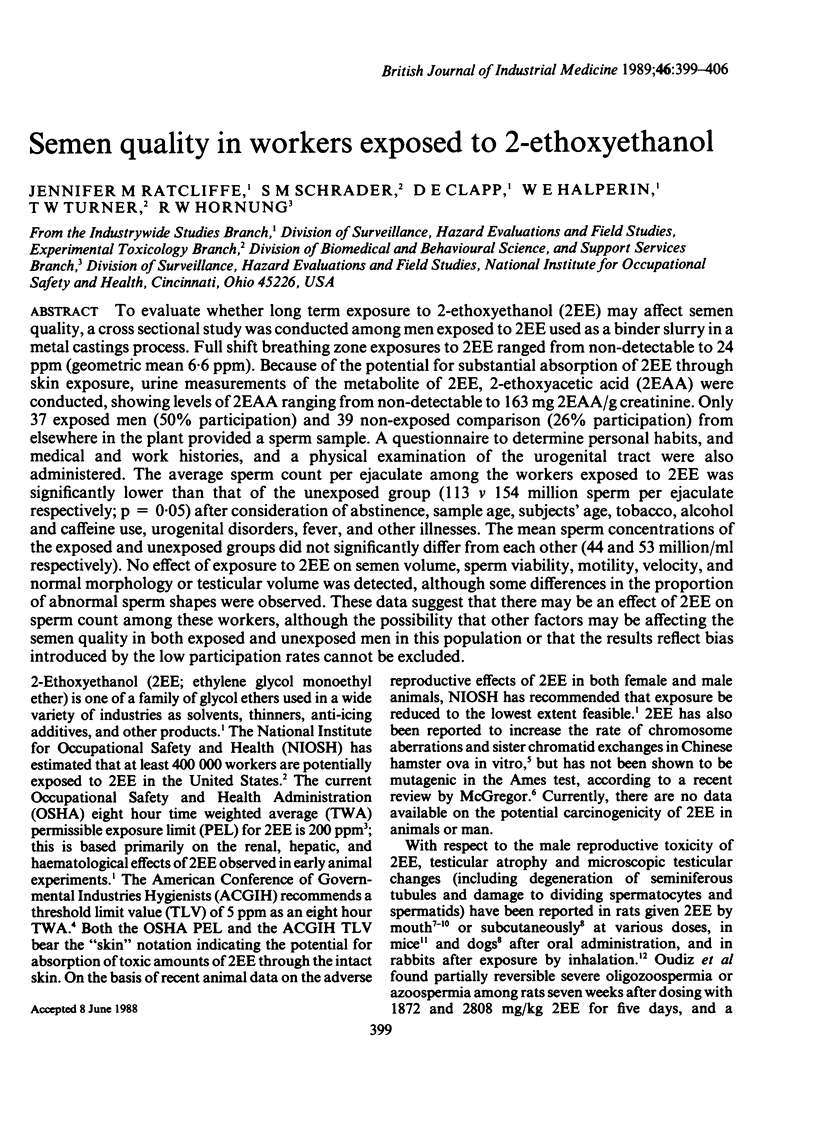
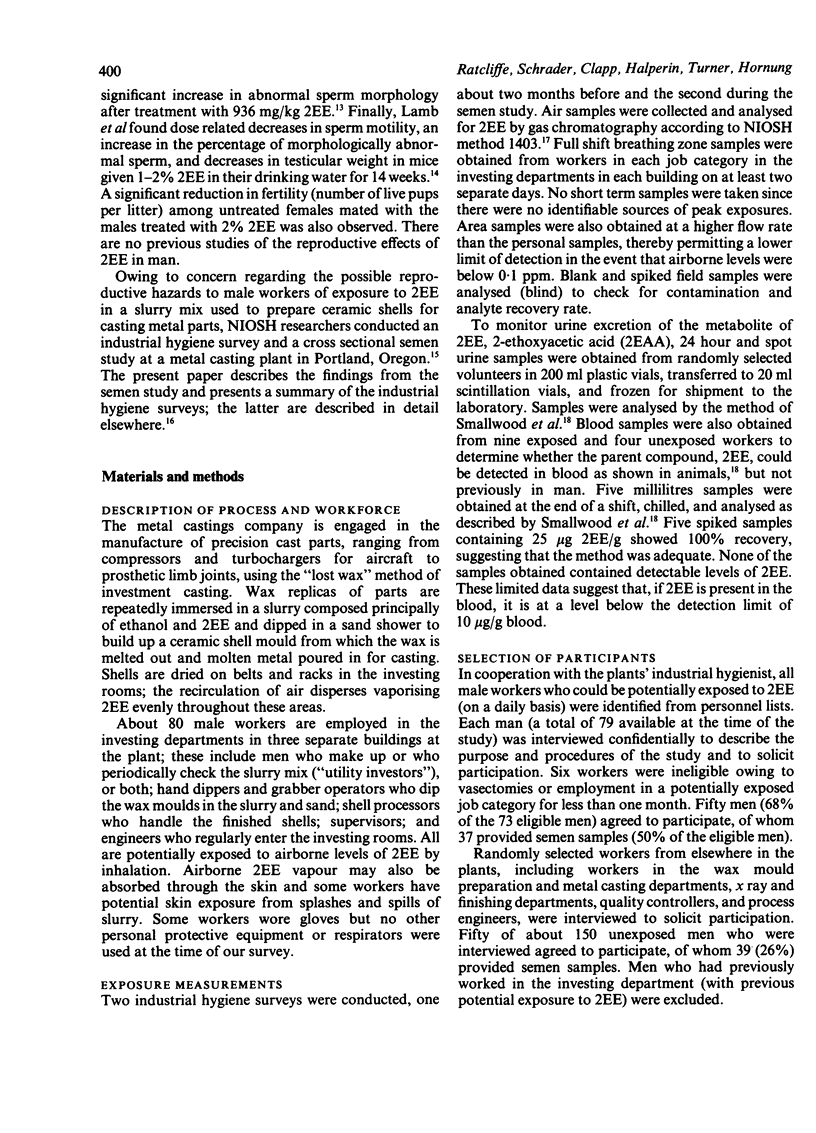
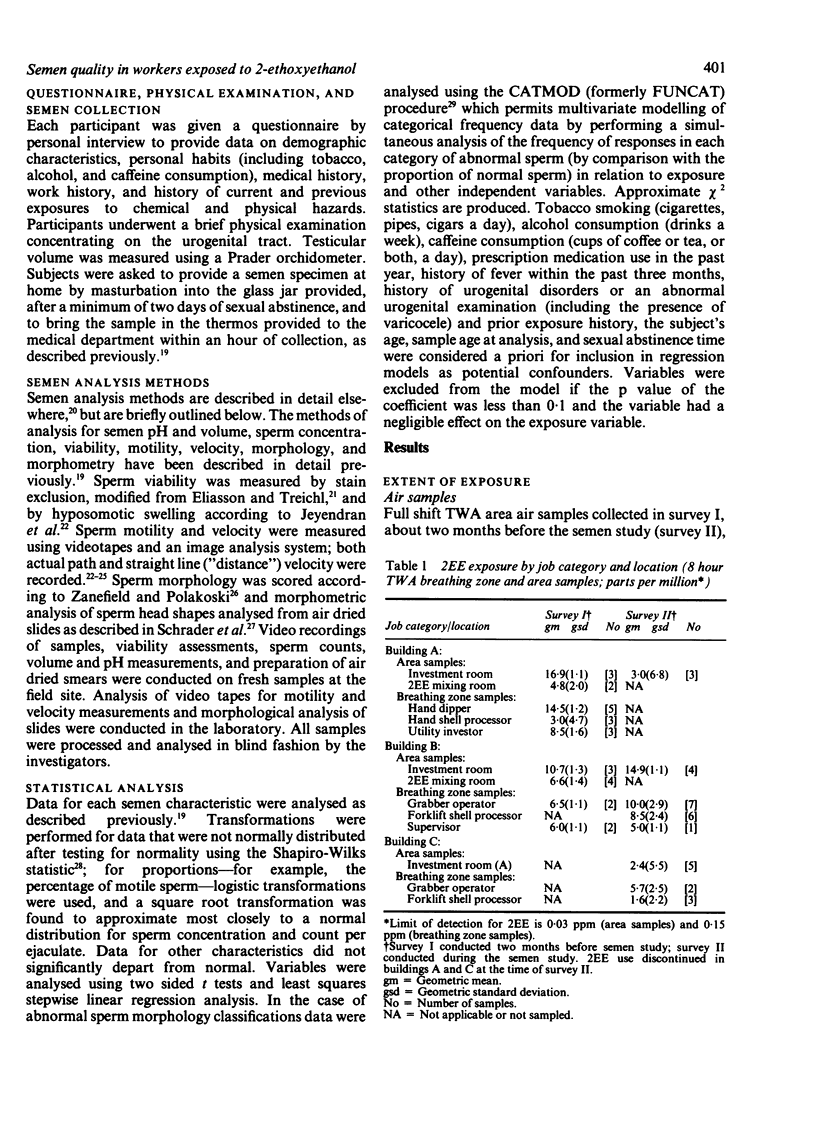

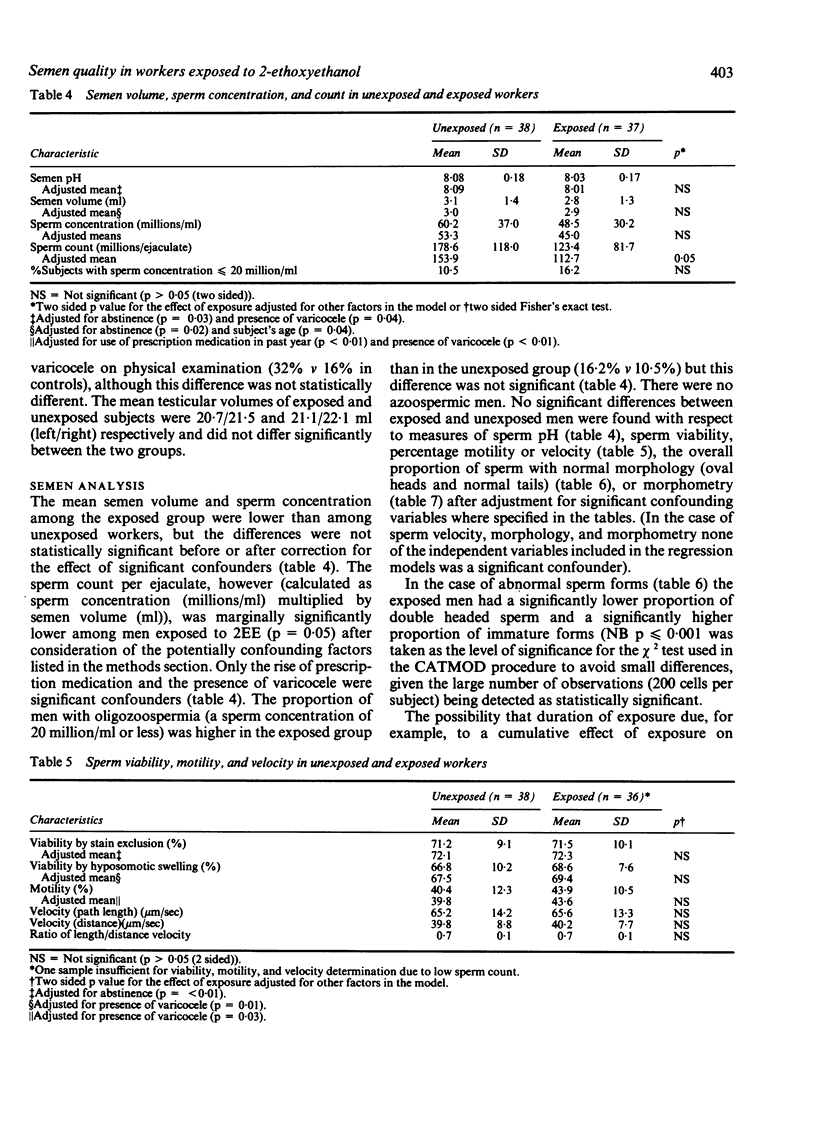


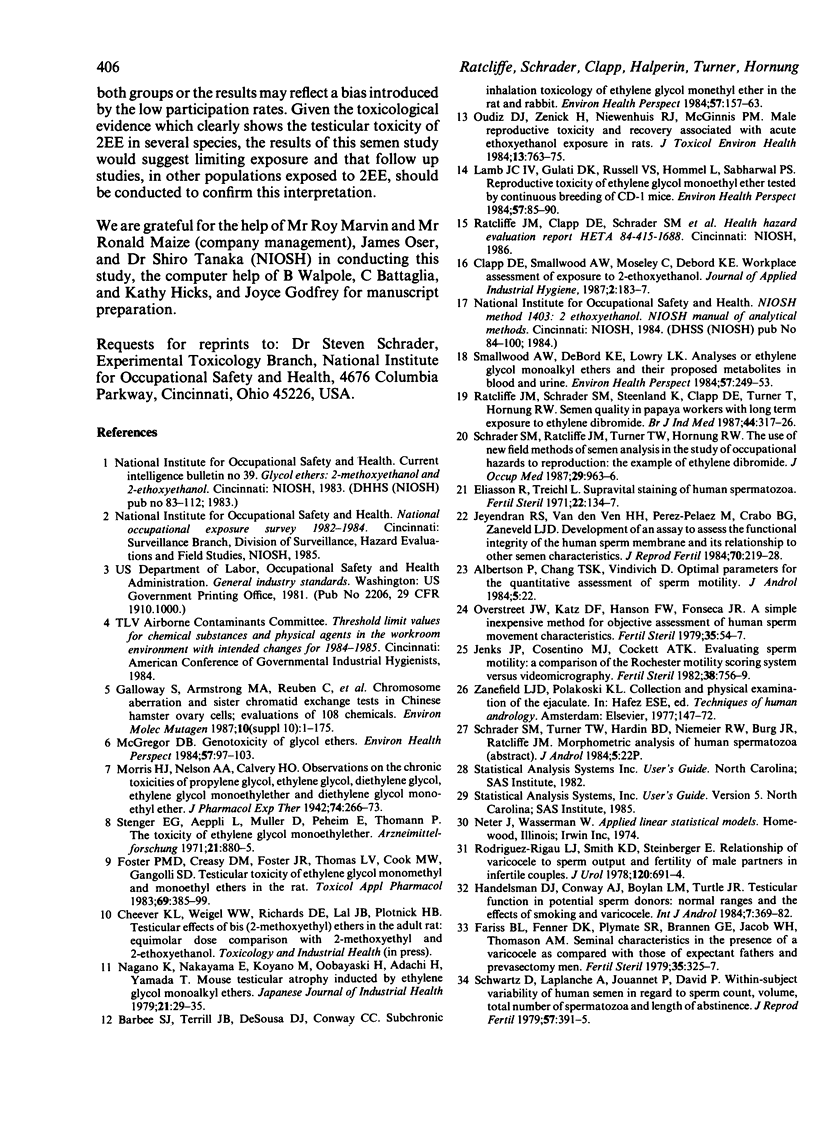
Selected References
These references are in PubMed. This may not be the complete list of references from this article.
- Barbee S. J., Terrill J. B., DeSousa D. J., Conaway C. C. Subchronic inhalation toxicology of ethylene glycol monoethyl ether in the rat and rabbit. Environ Health Perspect. 1984 Aug;57:157–163. doi: 10.1289/ehp.8457157. [DOI] [PMC free article] [PubMed] [Google Scholar]
- Eliasson R., Treichl L. Supravital staining of human spermatozoa. Fertil Steril. 1971 Feb;22(2):134–137. doi: 10.1016/s0015-0282(16)38049-9. [DOI] [PubMed] [Google Scholar]
- Fariss B. L., Fenner D. K., Plymate S. R., Brannen G. E., Jacob W. H., Thomason A. M. Seminal characteristics in the presence of a varicocele as compared with those of expectant fathers and prevasectomy men. Fertil Steril. 1981 Mar;35(3):325–327. doi: 10.1016/s0015-0282(16)45380-x. [DOI] [PubMed] [Google Scholar]
- Foster P. M., Creasy D. M., Foster J. R., Thomas L. V., Cook M. W., Gangolli S. D. Testicular toxicity of ethylene glycol monomethyl and monoethyl ethers in the rat. Toxicol Appl Pharmacol. 1983 Jul;69(3):385–399. doi: 10.1016/0041-008x(83)90262-4. [DOI] [PubMed] [Google Scholar]
- Galloway S. M., Armstrong M. J., Reuben C., Colman S., Brown B., Cannon C., Bloom A. D., Nakamura F., Ahmed M., Duk S. Chromosome aberrations and sister chromatid exchanges in Chinese hamster ovary cells: evaluations of 108 chemicals. Environ Mol Mutagen. 1987;10 (Suppl 10):1–175. doi: 10.1002/em.2850100502. [DOI] [PubMed] [Google Scholar]
- Handelsman D. J., Conway A. J., Boylan L. M., Turtle J. R. Testicular function in potential sperm donors: normal ranges and the effects of smoking and varicocele. Int J Androl. 1984 Oct;7(5):369–382. doi: 10.1111/j.1365-2605.1984.tb00794.x. [DOI] [PubMed] [Google Scholar]
- Jenks J. P., Cosentino M. J., Cockett A. T. Evaluating sperm motility: a comparison of the Rochester motility scoring system versus videomicrography. Fertil Steril. 1982 Dec;38(6):756–759. doi: 10.1016/s0015-0282(16)46708-7. [DOI] [PubMed] [Google Scholar]
- Jeyendran R. S., Van der Ven H. H., Perez-Pelaez M., Crabo B. G., Zaneveld L. J. Development of an assay to assess the functional integrity of the human sperm membrane and its relationship to other semen characteristics. J Reprod Fertil. 1984 Jan;70(1):219–228. doi: 10.1530/jrf.0.0700219. [DOI] [PubMed] [Google Scholar]
- Lamb J. C., 4th, Gulati D. K., Russell V. S., Hommel L., Sabharwal P. S. Reproductive toxicity of ethylene glycol monoethyl ether tested by continuous breeding of CD-1 mice. Environ Health Perspect. 1984 Aug;57:85–90. doi: 10.1289/ehp.845785. [DOI] [PMC free article] [PubMed] [Google Scholar]
- McGregor D. B. Genotoxicity of glycol ethers. Environ Health Perspect. 1984 Aug;57:97–103. doi: 10.1289/ehp.845797. [DOI] [PMC free article] [PubMed] [Google Scholar]
- Nagano K., Nakayama E., Koyano M., Oobayashi H., Adachi H., Yamada T. [Testicular atrophy of mice induced by ethylene glycol mono alkyl ethers (author's transl)]. Sangyo Igaku. 1979 Jan;21(1):29–35. doi: 10.1539/joh1959.21.29. [DOI] [PubMed] [Google Scholar]
- Oudiz D. J., Zenick H., Niewenhuis R. J., McGinnis P. M. Male reproductive toxicity and recovery associated with acute ethoxyethanol exposure in rats. J Toxicol Environ Health. 1984;13(4-6):763–775. doi: 10.1080/15287398409530538. [DOI] [PubMed] [Google Scholar]
- Ratcliffe J. M., Schrader S. M., Steenland K., Clapp D. E., Turner T., Hornung R. W. Semen quality in papaya workers with long term exposure to ethylene dibromide. Br J Ind Med. 1987 May;44(5):317–326. doi: 10.1136/oem.44.5.317. [DOI] [PMC free article] [PubMed] [Google Scholar]
- Rodriguez-Rigau L. J., Smith K. D., Steinberger E. Relationship of varicocele to sperm output and fertility of male partners in infertile couples. J Urol. 1978 Dec;120(6):691–694. doi: 10.1016/s0022-5347(17)57332-2. [DOI] [PubMed] [Google Scholar]
- Schrader S. M., Ratcliffe J. M., Turner T. W., Hornung R. W. The use of new field methods of semen analysis in the study of occupational hazards to reproduction: the example of ethylene dibromide. J Occup Med. 1987 Dec;29(12):963–966. [PubMed] [Google Scholar]
- Schwartz D., Laplanche A., Jouannet P., David G. Within-subject variability of human semen in regard to sperm count, volume, total number of spermatozoa and length of abstinence. J Reprod Fertil. 1979 Nov;57(2):391–395. doi: 10.1530/jrf.0.0570391. [DOI] [PubMed] [Google Scholar]
- Smallwood A. W., DeBord K. E., Lowry L. K. Analyses of ethylene glycol monoalkyl ethers and their proposed metabolites in blood and urine. Environ Health Perspect. 1984 Aug;57:249–253. doi: 10.1289/ehp.8457249. [DOI] [PMC free article] [PubMed] [Google Scholar]
- Stenger E. G., Aeppli L., Müller D., Peheim E., Thomann P. Zur Toxikologie des Athylenglykol-Monoäthyläthers. Arzneimittelforschung. 1971 Jun;21(6):880–885. [PubMed] [Google Scholar]


